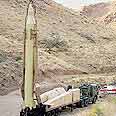
Iran test fires Shihab-3 missile
According to reports, test seen as partial success; it is unknown what problems took places during test of missile, which can reach 1,300 kilometers, but Iranians trying to increase range
The first test of the missile took place a number of years ago. The Iranians carried out a number of experiments on the missile in the past, part of which failed, and others claimed as a success.
The range of the missile of this model reaches 1,300 kilometers (806 miles), but according to reports that have come out of Iran in recent months, improvements on the missile have been carried out with the aim that it reach 2,000 kilometers (1,240 miles). It is fair to assume that the timing of the new test firing was preplanned for the Olmert-Bush summit.
According to reports, the experiment carried out Tuesday was classified as a partial success. It is unclear what problems took place during the experiment. At the end of 2004, Iran declared that the model will be manufactured by factories.
The Iranians' continued development of the missiles, including the Shihab-4 (which has a range over 2,000 kilometers), is already in advanced development stages, and points to a continuation of the Iranian phenomenon of developing long-range missiles alongside the nuclear program, and forming a threat to all of Europe in a number of years.
Major General Aharon Zeevi Farkash, the former IDF intelligence chief, warned last week that the Iranians will possess long-range missiles of 5,000 kilometers
(3,100 miles), "and all of Europe will be covered" as a result.
The defense community is closely following the Iranian experiments, alongside its monitoring of all that is linked to the nuclear development. Ballistic missiles experiments are thought to be the less worrying aspects for senior defense officials, while the assumption that the Iranians will have a nuclear ability by 2009 is seen as the real threat.
The defense establishment believes that the Iranians will overcome all obstacles in the development of ballistic missile developments compatible with nuclear warheads.
"The important issue is the future Iranian nuclear ability, rather than one particular missile or another. Everyone's eyes are fixed on the international community and the steps it will take against Iran on this issue," a defense source said.
Israeli cruise missile development making good progress
Meanwhile, Israel has speeded up efforts to develop long-range cruise missiles of a type that could be used should the Jewish state try to strike at Iran's nuclear facilities, security sources said on Tuesday.
Israel sent warplanes to destroy Iraq's main atomic reactor at Osiraq in 1981 and has not ruled out similar action to prevent its arch-foe from getting the bomb should US-led diplomatic pressure on Tehran fail.
The greater ranges to Iran's nuclear facilities might make cruise missiles more practical than planes, but the United States has rebuffed past Israeli requests to buy them.
Cruise missiles are programmed to seek out and hit distant targets, flying low to avoid radar. But only the United States and Russia are known to have mastered all aspects of production.
"A top priority has been put on developing this technology, in light of the Iran situation, as well as improving the Arrow," an Israeli security source said, referring to the anti-missile defense system designed by state-run Israel Aircraft Industries.
Jane's Defense Weekly said in 2004 that Israel Military Industries had fielded the country's first cruise missile, but its range was only around 300 km (190 miles).
There have also been media reports that government arms manufacturer Rafael created at least a prototype cruise missile by attaching a jet booster to its medium-range Popeye missile.
Israel asked Washington to sell it Tomahawk cruise missiles in 2000, during peace talks with Syria. Israel argued that it would need Tomahawks to make up for the loss of "strategic depth" were it to return the occupied Golan Heights to Syria.
The request went unmet. Defense experts saw US reluctance to stir up jitters among Israel's rivals in the Middle East.
"The United States would not want to export such a capable weapon at such sensitive times," said Jane's analyst Robert Hewson, noting that Tomahawks can carry nuclear warheads. Israel is believed to have the region's only atomic arsenal.
Iran is high on the agenda for Israeli Prime Minister Ehud Olmert on his current first visit to Washington. An Olmert confidant predicted that after a White House summit on Tuesday, Israel would renew its request for Tomahawks.
Israel might also argue that Olmert's plan to give up parts of the occupied West Bank, with or without a peace deal with the Palestinians, would cost Israel strategic depth that would need to be balanced with better weapons
.
"It (Tomahawk) was requested in the past. I believe it will be requested again, especially in light of the kind of threats Israel is facing in the future," the Olmert confidant said.
Some Israeli missile specialists, however, voiced skepticism about the usefulness of Tomahawks against Iranian nuclear facilities that are much better fortified than Osiraq was.
Israeli defiance analyst Alon Ben-David suggested the United States might end up supplying the Tomahawks in order to scotch Israel's rival cruise missile program.
"If the Americans discover that Israel is close to a credible cruise-missile capability, I expect they will be quick to curb it by finally coming up with the Tomahawks," he said.
Tomahawks are guided by a coded global positioning system network controlled by the Pentagon, meaning any Israeli launch would have to be approved by Washington.
Reuters contributed to the report










